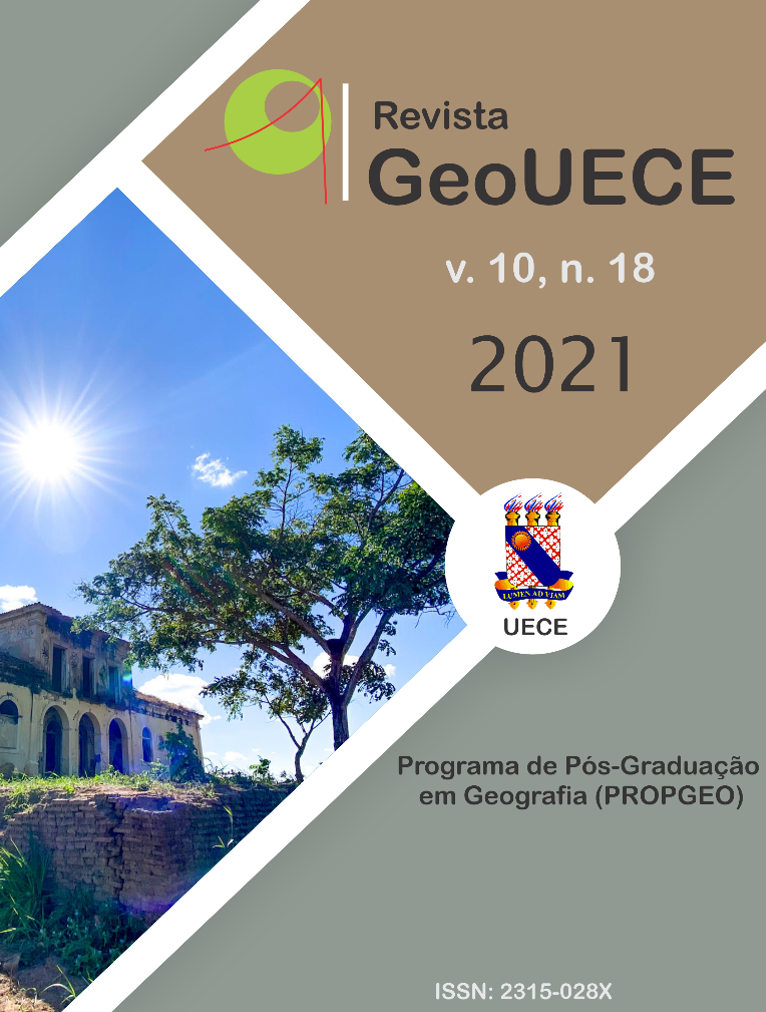Vol. 10 No. 18 (2021)

PRESENTATION
The context of the global public health crisis caused by the covid-19 pandemic reveals that solidarity, more than capitalist competitiveness, should be the basis for solving collective problems. This means, among others, the need for greater sharing of research, as we believe that the quality of academic knowledge is possible through cooperation. The GeoUECE Journal the Pos-Graduate Program in Geography of the State University of Ceará (PROPGEO/UECE), in addition to being a means of dissemination of what is produced about geographic knowledge in Brazil and in the world, it is also an electronic space for expression of political resistance, as the published works propose ways to seek constant social and environmental improvements that are not consistent with the current political decisions made on the scale of the national territory.
In its tenth volume, number 18, edition January-June 2021, the theme that structures the journal is quite diversified, as it permeates issues related to urban space, population dynamics and perception, as well as geomorphology, climatology, environmental conservation and epistemology linked to the approach to nature in geographic science. The works also represent the role of aspects of society and nature present in different parts of Brazil, with cutouts and case studies in the Midwest (Mato Grosso do Sul), Northeast (Ceará), North (Acre), Southeast (Rio) de Janeiro) and South (Rio Grande do Sul).
In this issue, still as part of the Journal's constant changes, we inaugurate the editorial with the thought-provoking text by Professor Reuben Rose-Rewood, Professor at the Department of Geography at the University of Victoria / Canada, who acts as one of GeoUECE's advisors.
The article entitled "The spatial practices of real estate developers and the patterns of real estate production in Macaé-RJ", by Oséias Teixeira da Silva, deals with capitalist real estate production in the structuring of cities, based on the practices of real estate developers. Next, the article by Fabrini Carvalho Mendes, entitled “Infant mortality: an analysis in Rio Grande de Sul (2010-2015)”, deals with the analysis of the Infant Mortality Coefficient, used as an indicator of social diagnosis in a specific area, in which the cutout is the state of Rio Grande do Sul. The results stand out the areas that need more actions and planning in the monitoring of pregnant women, which is in the prenatal phase. The article, “Hydrosedimentological dynamic of the middle Acre river: initial research of process of the sedimentation”, by Waldemir Lima dos Santos, Rafaela Ferreira de Oliveira and Cleyton Aguiar Crisóstomo, highlights theological dynamics in the Amazon river, where they are detected possible problems arising from the siltation process of the Acre River. Already “Geomorphological aspects of the São Joaquim formation in Northeast of Ceará state, Brazil”, an article by Abner Monteiro Nunes Cordeiro, Frederico de Holanda Bastos, Marcelo Martins de Moura Fé and Daniel dos Reis Cavalcante, expose how the morphostructural aspects and the lithological heterogeneity express particular features of the relief from differential erosion. Then, the article by Leonardo Danielli and Solismar Fraga Martins, entitled “The capitalist production and (re)production of urban space: a case study on the periphery of São João district, in the city of Pato Branco, state of Parana”, analyzes the capitalist production of urban space from actions of forced removal, which materializes processes of socio-spatial segregation. In the article "The place in dispute: experiences, perceptions and identity from territorial relations in the Santana Settlement, municipality of Brasilândia - MS", by the authors Beatriz Mercês de Souza dos Santos and Wilians Ventura Ferreira Souza, discussions the process of deterritorialization of riverside communities, in which, from the concept of place, the abrupt changes in the relations between the subject and the place are evidenced. Then, the text entitled “Taim Ecological Station: an analysis of the use of natural and physical space and environmental legislation”, by Marília Silva da Costa and Simone Emiko Sato, addresses the need for Fully Protected Conservation Units, as important for the maintenance of biological diversity and the physical-natural system, given the pressure and degradation generated by land uses. The article by Éder Leandro Bayer Maier and Bruna Cavalcanti Gautério, entitled “Socioeconomic characterization of the granizing precipitation in Rio Grande /RS: a case study on the granizing precipitation in September 2015 and its effects”, presents a socioeconomic characterization of the analysis of the precipitation of precipitation solids (hail), in order to map the environmental risk caused by this phenomenon, mainly on the damage caused. Completing the set of published articles, the text “Marine geography: a holistic approach”, built together by the authors Antônio Rodrigues Ximenes Neto, Francisco Oricélio da Silva Brindeiro, Francisco José Maciel de Moura, Luciano Filho de Sousa Paula, Paulo Roberto Silva Pessoa and Jader Onofre de Morais, highlights the aspects of epistemology in physical geography, considering the marine environment as part of the geographic space, due to the strong relationship with the emerging areas, in their various aspects (economic, social, political, physical-natural).
We wish you a good reading and we take this opportunity to reinforce that the GeoUECE Journal receives in a continuous flow articles, reviews, interviews and pedagogical experiences. Finally, we would like to thank those responsible for preparing this issue, especially our peer reviewers and editorial board, who have worked tirelessly to make the results of collectively produced reflections public.
Fortaleza (CE), July 2021.
Rafael BRITO
Denise BOMTEMPO
Editorial Coordination GeoUECE Journal.
































